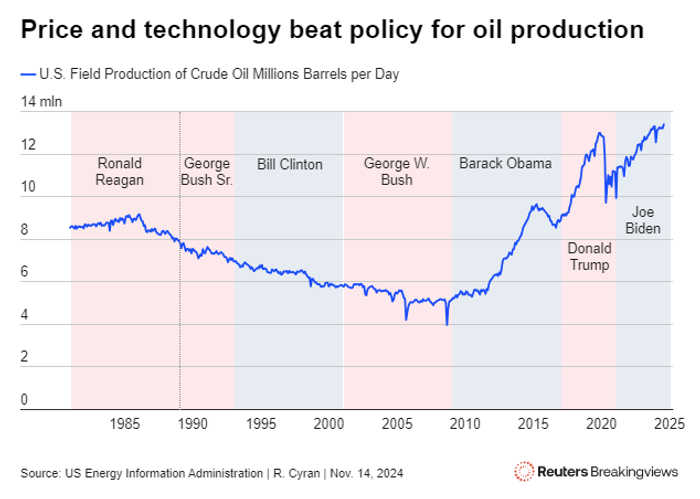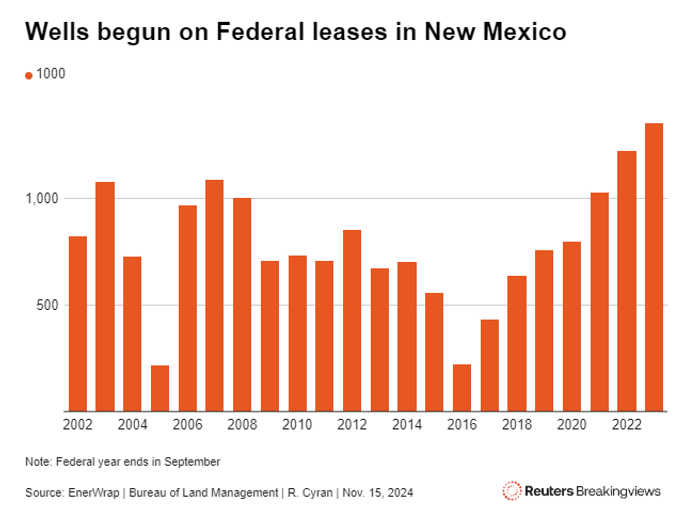Published 08:38 IST, November 20th 2024
US oil spigot bypasses the White House
U.S. crude oil output is expected to average a record 13.2 million barrels per day in 2024.
- Industry
- 3 min read

Nil, baby, nil. Want to know how much oil the United States could produce? Don’t look at the occupant of the White House for direction. Over the past five decades, it has not mattered. President-elect Donald Trump may want oil companies to “drill, baby, drill" but more important factors like price and capital returns demanded by investors are signaling restraint.
The idea that policy has little effect on production is counterintuitive. Yet U.S. output of the black stuff declined steadily under Ronald Reagan, Bill Clinton and former oil executive George W. Bush. In contrast, it rose steadily while Barack Obama, Trump, and Joe Biden occupied the Oval Office. The U.S. now pumps out over 13 million barrels per day, more than any other country, ever.

Neither the Democratic or Republican parties appear interested in restraining production over the near term. Higher economic growth, low gas prices and campaign donations from the energy industry help win elections. Technology also matters. The rise of hydraulic fracturing some 20 years ago, where drillers inject water, sand and chemicals into shale rock formations at high pressure, opened huge potential fields first in natural gas and then in oil. About two-thirds of U.S. crude now comes from so-called fracking, according to government figures.
While Trump says he will open up leasing and drilling on federal land, it’s not obvious the government is currently hindering production. About 70% of U.S. crude is produced on privately-held land. For example, the Permian Basin produces over 6 million barrels per day, with over two-thirds coming from Texas. There’s virtually no federally-owned land in this part of the Lone Star state, so easier leasing would not juice output. In New Mexico, where production has grown rapidly, drilling on federal land has already risen sharply over the last two administrations, points out energy data tracker EnerWrap.

More importantly, the financial rationale for expanding production is weak. The International Energy Agency this month said it thinks the world will produce 1 million barrels of surplus oil a day next year. The Organization of the Petroleum Exporting Countries is sitting on record spare capacity, as supply rises and renewable energy technologies eat into demand.
Trump’s administration could slow this shift by repealing U.S. clean energy subsidies. But electric vehicles keep falling in price, spurring adoption. Besides, phasing out federal support for renewable energy may face opposition in Congress as it benefits Republican strongholds.
Big oil companies already face pressure from investors to return capital if expected returns from increased production are poor. The five biggest Western firms, for example, together paid out a record $111 billion in dividends and share buybacks last year. When Trump turns the U.S. oil spigot, he may be met with little more than a trickle.
Context News
U.S. crude oil output is expected to average a record 13.2 million barrels per day in 2024, according to the Energy Information Administration’s short-term outlook released on Nov. 13. That is the most oil produced by any country, ever. The Federal agency expects production in 2025 to rise to 13.5 million barrels per day.
President-elect Donald Trump has said he would increase production. The Republican party’s platform for the 2024 election said, “Under President Trump, the U.S. became the Number One Producer of Oil and Natural Gas in the World — and we will soon be again by lifting restrictions on American Energy Production and terminating the Socialist Green New Deal.”
Updated 08:38 IST, November 20th 2024